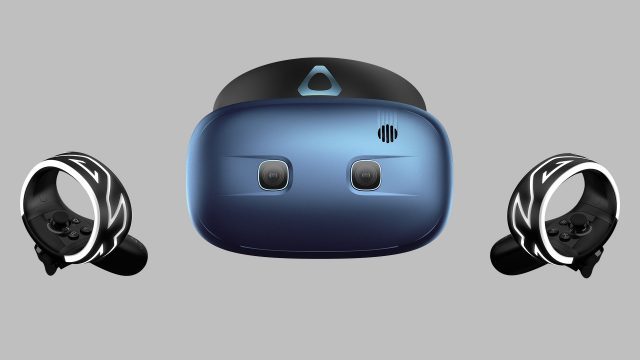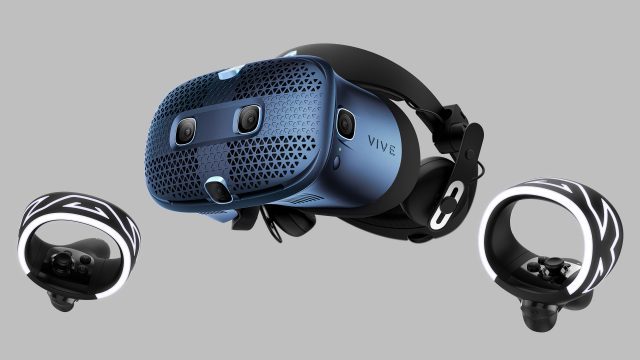
Buckle up, this one’s a doozy. HTC today introduced three new variants of its Vive Cosmos VR headset. Joining the original Cosmos is Cosmos Elite, Cosmos Play, and Cosmos XR. The four variants of the headset aim to cover a diverse set of customer interests.
After a bumpy launch for Vive Cosmos back in October 2019, and a new CEO taking the reins at HTC, the company is effectively relaunching Cosmos by introducing a series of Cosmos headsets which seek to appeal to a wide range of VR users from the novice to the high-end enthusiast and everywhere in-between.

Each Cosmos headset uses the same foundation as the original—which means the same flip-up head-mount design, fresnel lenses, and 1,440 × 1,700 LCD displays with hardware IPD adjustment—but the variants take advantage of the headset’s interchangeable faceplate to offer different capabilities. To help make sense of all of this, here’s a quick outline first, with more details further down.
- Vive Cosmos Play – $500
- Entry-level
- Inside-out tracking (4 cameras)
- Cosmos controllers
- Vive Cosmos – $700
- Mid-tier
- Inside-out tracking (6 cameras)
- Cosmos controllers
- Vive Cosmos Elite – $900
- High-end
- SteamVR Tracking (includes two base stations)
- Vive wand controllers
- Vive Cosmos XR – Price unannounced
- Developer kit made for pass-through AR
- Inside-out tracking (4 cameras + 2 HQ pass-through cameras)
- Cosmos controllers
Vive Cosmos Play

Cosmos Play is HTC’s entry-level VR offering which has four cameras for inside-out tracking, and the same controllers as the original Cosmos. From photos it appears the Play will not include integrated audio, but instead provide a 3.5mm headphone jack for users to plug in their own headphones.
With less tracking coverage than the original Cosmos (which has six cameras), HTC is positioning the Cosmos Play as ideal for casual VR experiences. The company also calls the headset an entry-point into VR because users can choose to upgrade it in the future with faceplates from the other Cosmos variants.
HTC plans to offer the Cosmos Play for $500, though a release date hasn’t been announced.
Vive Cosmos

This is the original Cosmos as it launched back in October; its faceplate adds two additional cameras over the Play (for a total of six) which increase inside-out tracking coverage (specifically, more vertical coverage), and it will continue to use the same controllers that it launched with.
HTC will continue to offer Cosmos at the same $700 price point that it established at launch.
The Cosmos faceplate (with the two extra cameras) will become available as a separate accessory in Q2 for $200; it’ll be able to attach to any of the other Cosmos variants.
Vive Cosmos Elite

Vive Cosmos Elite is targeted directly at the enthusiast crowd and comes equipped with a SteamVR Tracking faceplate and includes two Vive wand controllers and two tracking base stations.
SteamVR Tracking is the same tracking technology used in the original Vive. Though it requires external base stations to function, SteamVR Tracking is considered a gold-standard of VR tracking for its precision and accuracy, which makes it an appealing choice for VR enthusiasts who don’t mind mounting tracking hardware around their room.
What many enthusiasts will mind, however, is the necessary inclusion of the Vive wand controllers with the Cosmos Elite. Though they track well thanks to SteamVR Tracking, the Vive wands are widely considered last-gen VR controllers due to their use of a trackpad and grab button. More recent VR controllers have coalesced around thumbsticks (rather than trackpads) and grab triggers or pressure-sensitive grab handles (rather than grab buttons); even HTC’s own Cosmos controllers have thumbsticks and grab triggers.
Cosmos Elite will be available in Q1 and priced at $900—which puts it in direct competition with the company’s own Vive Pro ($900) and Valve’s Index ($1,000). Pre-orders for Cosmos Elite will start next week on February 24th.

HTC plans to offer the Cosmos SteamVR Tracking faceplate (which the company calls the ‘External Tracking Faceplate’) as a standalone accessory which can attach to any of the other Cosmos headsets. That creates a path for any other Cosmos headset to be upgraded into the SteamVR Tracking ecosystem… but you’ll still need to shell out for separate base stations and controllers.
Ostensibly one could buy Cosmos Play at $500 and the External Tracking Faceplate for $200, making a Cosmos Elite for $700 (sans base stations and controllers). HTC also says Cosmos Elite will support outside-in tracking just like the other Cosmos headsets, but you’d need to pick up a pair of the Cosmos controllers for input. A bit convoluted, perhaps—but hey—that’s Cosmos’ modularity in action, right?
Vive Cosmos XR

Vive Cosmos XR will launch as a developer-focused headset aimed at pass-through augmented reality. Pass-through augmented reality uses cameras to show the outside world inside of the headset and then projects virtual imagery into the feed of the real world; the headset will be able to do pure VR too.
Though all Cosmos headsets support a pass-through video view, the Cosmos XR comes equipped with its own special faceplate that adds two more front-facing cameras to the headset which bring a higher quality and wider field of view pass-through feed than the cameras built into the core Cosmos headset, HTC says.

However, the HQ pass-through cameras on the Cosmos XR faceplate appear to be positioned below the user’s eye-line which may make for an odd perspective unless HTC is doing some computer-vision trickery to adjust the view.
HTC says Cosmos XR will launch in Q2 as a developer kit; pricing has not been announced, but the company promises to share more at GDC next month.
– – — – –
So there you have it. The complete Vive Cosmos lineup, and HTC’s vision for an ecosystem of modular VR headsets. How does it all stack up to other headset options on the market? Let us know what you think in the comments.
The post HTC Unveils Three New Vive Cosmos Headsets: Elite, Play, and XR appeared first on Road to VR.
Ream more: https://www.roadtovr.com/htc-vive-cosmos-series-cosmos-elite-cosmos-play-cosmos-xr/
No comments:
Post a Comment